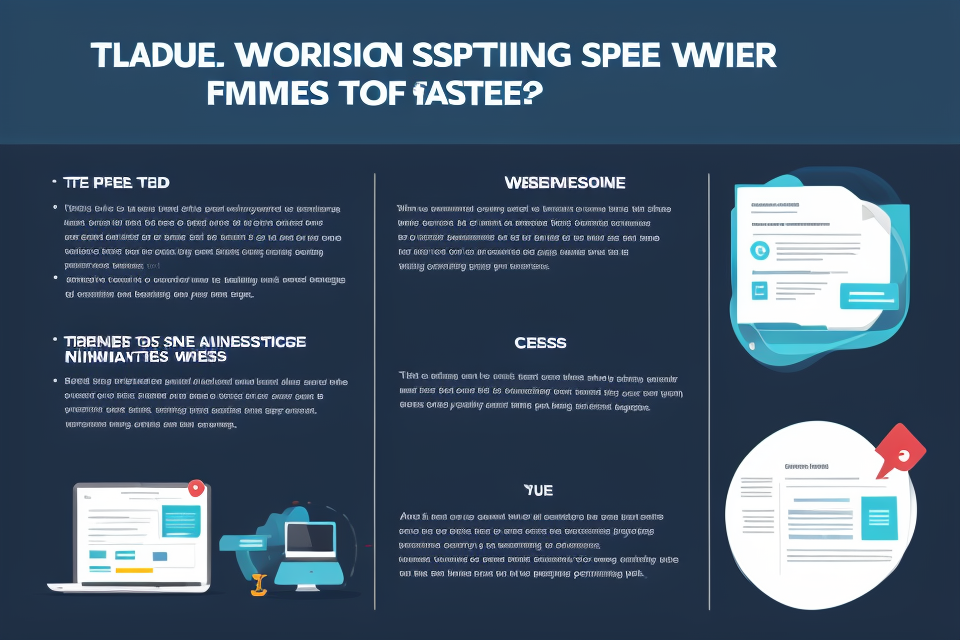In today’s fast-paced digital world, where users expect seamless and instant experiences, site speed has emerged as a critical factor for the success of any online business. It refers to the time it takes for a website to load its content, and it plays a crucial role in determining the user experience, search engine rankings, and conversion rates. A slow-loading website can lead to increased bounce rates, decreased user engagement, and reduced conversion rates, ultimately affecting the bottom line of a business. On the other hand, a fast-loading website can improve user experience, increase user engagement, and boost search engine rankings, leading to higher conversion rates and revenue. In this comprehensive guide, we will delve into the significance of site speed and explore the various factors that influence it, along with tips and best practices for optimizing site speed for better business outcomes.
Understanding Site Speed: What it Means and Why it Matters
What is Site Speed?
- Definition and Explanation
- Importance of Site Speed
Site speed refers to the time it takes for a website to load and display its content to users. It is measured in seconds and is calculated from the moment a user requests a web page to the moment the page is fully loaded and displayed in the browser.
A slow-loading website can have a negative impact on user experience, leading to higher bounce rates, lower engagement, and decreased conversion rates. On the other hand, a fast-loading website can lead to improved user satisfaction, increased engagement, and higher conversion rates.
Therefore, site speed is an essential factor in determining the success of a website. It is crucial to optimize site speed to ensure that users have a positive experience on the website and to improve the website’s overall performance.
Factors Affecting Site Speed
- Server response time
- Page load time
- Bandwidth
- Content size and type
- Image optimization
Server Response Time
Server response time refers to the time it takes for a server to respond to a user’s request for a webpage. This can be influenced by various factors such as the number of users accessing the site, server location, and server hardware. A slow server response time can result in a delayed page load time, which can negatively impact user experience and search engine rankings.
Page Load Time
Page load time is the time it takes for a webpage to load in a user’s browser. This includes the time it takes for the server to respond, the time it takes for the browser to request the page, and the time it takes for the page to load in the browser. A slow page load time can lead to a higher bounce rate, lower user engagement, and decreased conversion rates.
Bandwidth
Bandwidth refers to the amount of data that can be transmitted over a network connection. A website with high bandwidth requirements may take longer to load, especially for users with slower internet connections. This can lead to a negative user experience and can impact search engine rankings.
Content Size and Type
The size and type of content on a webpage can also affect page load time. Large files such as videos, images, and PDFs can take longer to load, especially if they are not optimized for the web. In addition, complex scripts and code can also slow down a webpage. Optimizing content and code can help improve page load time and enhance user experience.
Image Optimization
Images are a crucial part of many websites and can significantly impact page load time. Large images can slow down a webpage, especially if they are not optimized for the web. Image optimization techniques such as compressing images, using appropriate file formats, and optimizing image dimensions can help improve page load time and enhance user experience.
The Impact of Site Speed on User Experience
Effects on Conversion Rates
One of the most critical aspects of site speed is its impact on conversion rates. A website that loads quickly is more likely to convert visitors into customers or subscribers. This section will delve into the specific effects of site speed on conversion rates.
- Decreased bounce rates: A fast-loading website is more likely to keep visitors engaged and reduce bounce rates. When visitors stay on a website longer, they are more likely to convert. Therefore, a faster website can lead to lower bounce rates and higher conversion rates.
- Increased engagement: Site speed also affects engagement levels. Visitors who experience a fast website are more likely to engage with the content, explore more pages, and spend more time on the site. This increased engagement can lead to higher conversion rates.
- Improved user satisfaction: A website that loads quickly is more satisfying for users. Visitors who experience a fast website are more likely to have a positive perception of the website and the brand. This improved user satisfaction can lead to higher conversion rates, as visitors are more likely to trust and engage with a website that provides a positive user experience.
Overall, site speed has a direct impact on conversion rates. A website that loads quickly is more likely to keep visitors engaged, reduce bounce rates, and increase conversion rates. Therefore, website owners and marketers should prioritize site speed as a critical factor in their website optimization strategies.
Effects on Search Engine Rankings
Website speed plays a crucial role in determining a website’s search engine rankings. Search engines like Google take several factors into account when determining a website’s ranking, including page load time. In this section, we will delve deeper into the effects of site speed on search engine rankings.
Google’s PageSpeed Report
Google’s PageSpeed report is a useful tool that provides information about a website’s performance and identifies areas for improvement. The report assesses a website’s loading speed and provides a score out of 100. This score is based on several factors, including the website’s page load time, server response time, and the use of optimized images and videos.
Factors Considered by Search Engines
Search engines like Google consider several factors when determining a website’s ranking, including:
- Page load time: This refers to the time it takes for a webpage to load in a web browser. A slower page load time can negatively impact a website’s ranking.
- Mobile responsiveness: With the increasing use of mobile devices, search engines like Google prioritize websites that are optimized for mobile devices.
- Security: Websites that use HTTPS encryption and have an SSL certificate are prioritized by search engines.
- Content quality: Websites with high-quality, relevant content are prioritized by search engines.
How Site Speed Affects SEO
Website speed is an important factor in search engine optimization (SEO). A website that loads quickly is more likely to keep visitors on the site and encourage them to explore more pages, which can improve the website’s ranking. Additionally, a website that loads quickly is more likely to receive more frequent updates and new content, which can also improve its ranking.
On the other hand, a website that loads slowly can have a negative impact on its ranking. Slow-loading websites can lead to higher bounce rates, which can indicate to search engines that the website is not providing a good user experience. This can result in lower rankings and fewer visitors to the website.
In conclusion, website speed is an important factor in determining a website’s search engine rankings. Websites that load quickly are more likely to receive higher rankings and more frequent updates, while websites that load slowly may suffer from lower rankings and fewer visitors. By optimizing website speed, website owners can improve their website’s performance and increase their chances of success in the competitive world of online marketing.
The Business Case for Site Speed
The ROI of Site Speed
Site speed is a critical factor that can have a significant impact on a website’s success. The return on investment (ROI) of site speed is undeniable, and businesses that prioritize it can reap significant benefits.
- Increased sales and revenue: A faster website can lead to increased sales and revenue. This is because a faster website provides a better user experience, which can result in higher conversion rates. Additionally, a faster website can improve search engine rankings, leading to more organic traffic and potentially more sales.
- Cost savings from reduced bounce rates: A slow website can lead to high bounce rates, which can be costly for businesses. Bounce rates refer to the percentage of visitors who leave a website after viewing only one page. A high bounce rate can indicate that visitors are leaving because the website is too slow to load, resulting in a poor user experience. By improving site speed, businesses can reduce bounce rates, which can result in cost savings from reduced server and hosting expenses.
- Improved customer loyalty: A fast website can also lead to improved customer loyalty. When a website loads quickly, it can build trust with visitors, as it demonstrates that the business is professional and capable. Additionally, a fast website can make it easier for customers to find the information they need, which can lead to improved customer satisfaction and loyalty.
Competitive Advantage
- How site speed differentiates brands
Site speed is an essential factor that sets brands apart from their competitors. A fast website provides a better user experience, which in turn enhances brand reputation and credibility. Conversely, a slow website can negatively impact brand image and drive potential customers away. - Impact on customer acquisition and retention
A study conducted by Google and the Boston Consulting Group found that a delay of just one second in page load time can result in a 20% decrease in customer conversion rates. Therefore, ensuring site speed can significantly impact customer acquisition and retention. A fast website can attract more visitors and retain existing ones, leading to increased revenue and growth. - Competitive benchmarking
Monitoring site speed against competitors is crucial in identifying opportunities for improvement. Websites that load faster than competitors can provide a competitive advantage by enhancing user experience and potentially increasing market share. Tools such as Google PageSpeed Insights and WebPageTest can help track site speed performance and identify areas for optimization.
In conclusion, site speed plays a crucial role in creating a competitive advantage for businesses. It directly impacts customer acquisition and retention, and monitoring site speed against competitors can provide valuable insights for improvement.
Optimizing Site Speed: Strategies and Best Practices
Technical Optimization
Caching
Caching is a technique that involves storing frequently accessed data in a temporary storage location to reduce the load on the server and improve website performance. There are several types of caching, including browser caching, server caching, and database caching. Browser caching allows the browser to store some or all of the website’s files on the user’s computer, so that the website can be loaded faster the next time the user visits. Server caching involves storing data on the server to reduce the load on the database. Database caching involves storing data in memory to reduce the load on the database.
Minification
Minification is the process of removing unnecessary characters from code, such as whitespace and comments, to reduce the size of the code and improve website performance. This can be done manually or using tools such as Minify or Google’s Closure Compiler.
Content Delivery Networks (CDNs)
A Content Delivery Network (CDN) is a network of servers that work together to deliver content to users based on their geographic location. This allows for faster and more efficient delivery of content, particularly for users in remote locations.
Browser caching
Browser caching allows the browser to store some or all of the website’s files on the user’s computer, so that the website can be loaded faster the next time the user visits. This can be done using the Cache-Control header in the HTTP response, which tells the browser how long to cache the files.
Optimizing images
Images can be a significant source of slow website performance, as they often require a lot of data to be transferred. To optimize images, it is important to reduce their file size without sacrificing quality. This can be done by using lossless or lossy compression, reducing the number of colors or pixels, and using a proper file format such as JPEG or PNG. Additionally, it is important to ensure that images are properly sized and formatted for the web, and to use appropriate image alt tags and descriptions for accessibility.
User Experience Optimization
When it comes to optimizing site speed, user experience plays a crucial role. By improving the user experience, you can enhance the overall performance of your website and provide a more satisfying experience for your visitors. Here are some strategies for optimizing user experience:
Reducing the Number of Requests
One of the most effective ways to improve site speed is by reducing the number of requests made by your website. Each request made by a user to the server requires processing time, which can slow down the loading speed of your website. By minimizing the number of requests, you can significantly improve the overall performance of your website. This can be achieved by combining multiple files into one, using image optimization techniques, and reducing the number of plugins and scripts on your website.
Limiting the Use of External Resources
Another effective strategy for optimizing user experience is by limiting the use of external resources. External resources such as images, videos, and scripts can significantly slow down the loading speed of your website. By limiting the use of external resources, you can reduce the number of requests made by your website and improve the overall performance of your website. This can be achieved by hosting your own images and videos, using local scripts, and using content delivery networks (CDNs) to serve static content.
Minimizing Redirects
Minimizing redirects is another important strategy for optimizing user experience. Each redirect requires additional processing time, which can slow down the loading speed of your website. By minimizing the number of redirects, you can improve the overall performance of your website. This can be achieved by avoiding unnecessary redirects, using URL redirects, and optimizing your website’s URL structure.
Prioritizing Visible Content
Prioritizing visible content is another effective strategy for optimizing user experience. By prioritizing the visible content of your website, you can ensure that the most important elements of your website are loaded first. This can significantly improve the overall performance of your website and provide a more satisfying experience for your visitors. This can be achieved by using lazy loading, prioritizing above-the-fold content, and optimizing your website’s loading sequence.
Progressive Rendering
Progressive rendering is another effective strategy for optimizing user experience. By progressively rendering your website’s content, you can ensure that the most important elements of your website are loaded first, while the rest of the content is loaded in the background. This can significantly improve the overall performance of your website and provide a more satisfying experience for your visitors. This can be achieved by using JavaScript and CSS to load the most important content first, and using techniques such as incremental loading and dynamic rendering.
Monitoring and Measuring Site Speed
Monitoring and measuring site speed is an essential aspect of optimizing a website’s performance. It allows website owners and administrators to track the site’s speed over time, identify areas that need improvement, and measure the impact of any changes made to the site.
Tools for monitoring site speed
There are several tools available for monitoring site speed, including:
- Google PageSpeed Insights: A free tool that provides information about a site’s performance on both mobile and desktop devices, along with recommendations for improvement.
- GTmetrix: A performance analysis tool that provides detailed information about a site’s loading time, along with suggestions for optimization.
- Pingdom: A website speed testing tool that simulates real-world loading conditions and provides detailed reports on site performance.
Importance of regular testing
Regular testing of site speed is crucial to ensuring that a website is performing optimally. It allows website owners and administrators to identify issues before they become major problems and to track the impact of any changes made to the site.
Understanding site speed reports
Site speed reports provide valuable information about a site’s performance, including the time it takes to load pages, the number of requests made by the server, and the size of the page’s assets. Understanding these reports is essential to identifying areas of improvement and implementing effective optimization strategies.
In conclusion, monitoring and measuring site speed is a critical aspect of optimizing a website’s performance. By using the right tools, conducting regular testing, and understanding site speed reports, website owners and administrators can ensure that their site is performing optimally and providing the best possible user experience.
The Future of Site Speed: Emerging Trends and Challenges
Mobile Optimization
- The importance of mobile site speed
- The rapid growth of mobile traffic
- The increasing use of mobile devices for online shopping and other transactions
- The need for a seamless user experience on mobile devices
- Strategies for optimizing mobile site speed
- Minimizing the size of images and videos
- Using browser caching and CDNs
- Optimizing server response time
- Reducing the number of HTTP requests
- Implementing Accelerated Mobile Pages (AMP)
- Prioritizing website performance in website design and development
- Monitoring and measuring mobile site speed using tools such as Google PageSpeed Insights and GTmetrix.
Emerging Technologies
The impact of new technologies on site speed
In the fast-paced world of technology, it is essential to keep up with the latest advancements in order to maintain a competitive edge. With the rapid growth of the internet and the increasing reliance on online services, the need for fast-loading websites has become a top priority for businesses.
New technologies are constantly emerging that have the potential to significantly impact site speed. For example, the use of progressive web apps (PWAs) has become increasingly popular, as they allow for faster loading times and improved user experience. Similarly, the use of AMP (Accelerated Mobile Pages) technology can help to significantly reduce load times on mobile devices.
How to prepare for future trends
In order to stay ahead of the curve, it is important to stay informed about emerging technologies and their potential impact on site speed. This includes staying up-to-date on industry news and trends, as well as regularly reviewing and updating your website to take advantage of new technologies as they become available.
It is also important to prioritize user experience and to conduct regular user testing to ensure that your website is performing optimally for all users. By staying proactive and staying ahead of the curve, businesses can ensure that their website remains fast and reliable, even as new technologies continue to emerge.
Challenges and Opportunities
As the digital landscape continues to evolve, so too does the importance of site speed. While there are many benefits to be gained from optimizing site speed, there are also several challenges that must be overcome.
Balancing speed with functionality
One of the biggest challenges faced by website owners and developers is finding the right balance between site speed and functionality. While it’s important to ensure that a website loads quickly, it’s also crucial to ensure that it provides users with the information and features they need. This can be a difficult balance to strike, as making a website too simple can lead to a poor user experience, while making it too complex can slow it down.
Adapting to changing user expectations
Another challenge facing website owners and developers is adapting to changing user expectations. As users become more accustomed to fast-loading websites, they are less likely to tolerate slow-loading sites. This means that website owners and developers must constantly strive to improve site speed in order to meet the expectations of their users.
The role of artificial intelligence in site speed optimization
Artificial intelligence (AI) is increasingly being used to optimize site speed. AI can be used to analyze large amounts of data and identify patterns that can be used to improve site speed. For example, AI can be used to optimize image sizes, reduce server response times, and improve caching. As AI continues to evolve, it’s likely that it will play an even more important role in site speed optimization.
Overall, while there are many challenges to be faced in the future of site speed, there are also many opportunities for website owners and developers to improve the speed of their websites. By staying up-to-date with emerging trends and challenges, and by utilizing new technologies like AI, it’s possible to create websites that are fast, functional, and user-friendly.
FAQs
1. What is site speed?
Site speed refers to the time it takes for a website to load and become fully functional. It is an important factor that affects the user experience, search engine rankings, and overall success of a website.
2. Why is site speed important?
Site speed is important because it can affect user engagement, search engine rankings, and revenue. A website that loads quickly will keep users on the site longer, leading to increased engagement and revenue. Additionally, search engines like Google take site speed into account when ranking websites, so a faster website is more likely to rank higher in search results.
3. How can I improve my website’s speed?
There are several ways to improve your website’s speed, including optimizing images, reducing the number of HTTP requests, using a content delivery network (CDN), and minimizing the use of large scripts and plugins. Additionally, regularly updating your website’s software and hardware can also help improve speed.
4. What are the consequences of a slow website?
A slow website can have several negative consequences, including lower user engagement, reduced search engine rankings, and decreased revenue. Additionally, users may become frustrated and leave the site, leading to a higher bounce rate.
5. Is site speed affected by the user’s internet connection?
Yes, site speed can be affected by the user’s internet connection. However, a website that is optimized for speed will still load quickly even on slower connections. This is because optimized websites use techniques such as image optimization and caching to reduce the amount of data that needs to be transferred over the internet.
6. Can site speed be improved without affecting the website’s functionality?
Yes, site speed can often be improved without affecting the website’s functionality. For example, optimizing images and reducing the number of HTTP requests can improve speed without affecting the website’s look or feel. Additionally, using a content delivery network (CDN) can also improve speed without affecting the website’s functionality.
7. Is site speed important for mobile devices?
Yes, site speed is important for mobile devices. In fact, it is even more important for mobile devices because mobile users typically have slower internet connections and less patience for waiting for websites to load. Additionally, Google has announced that it will be using mobile site speed as a ranking factor in its search algorithm.



